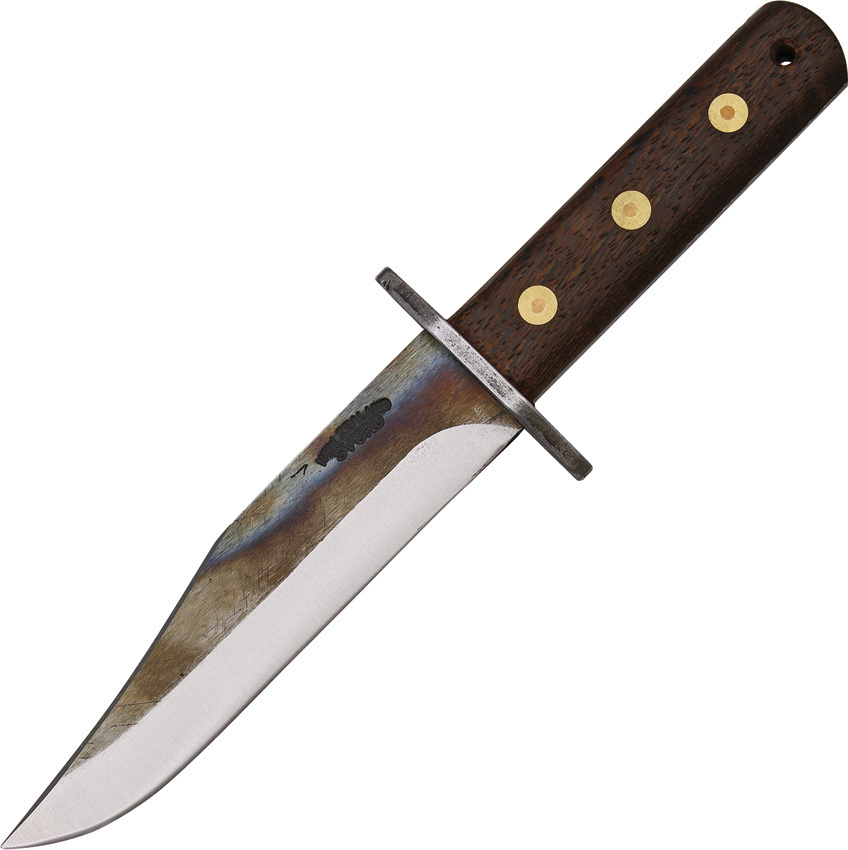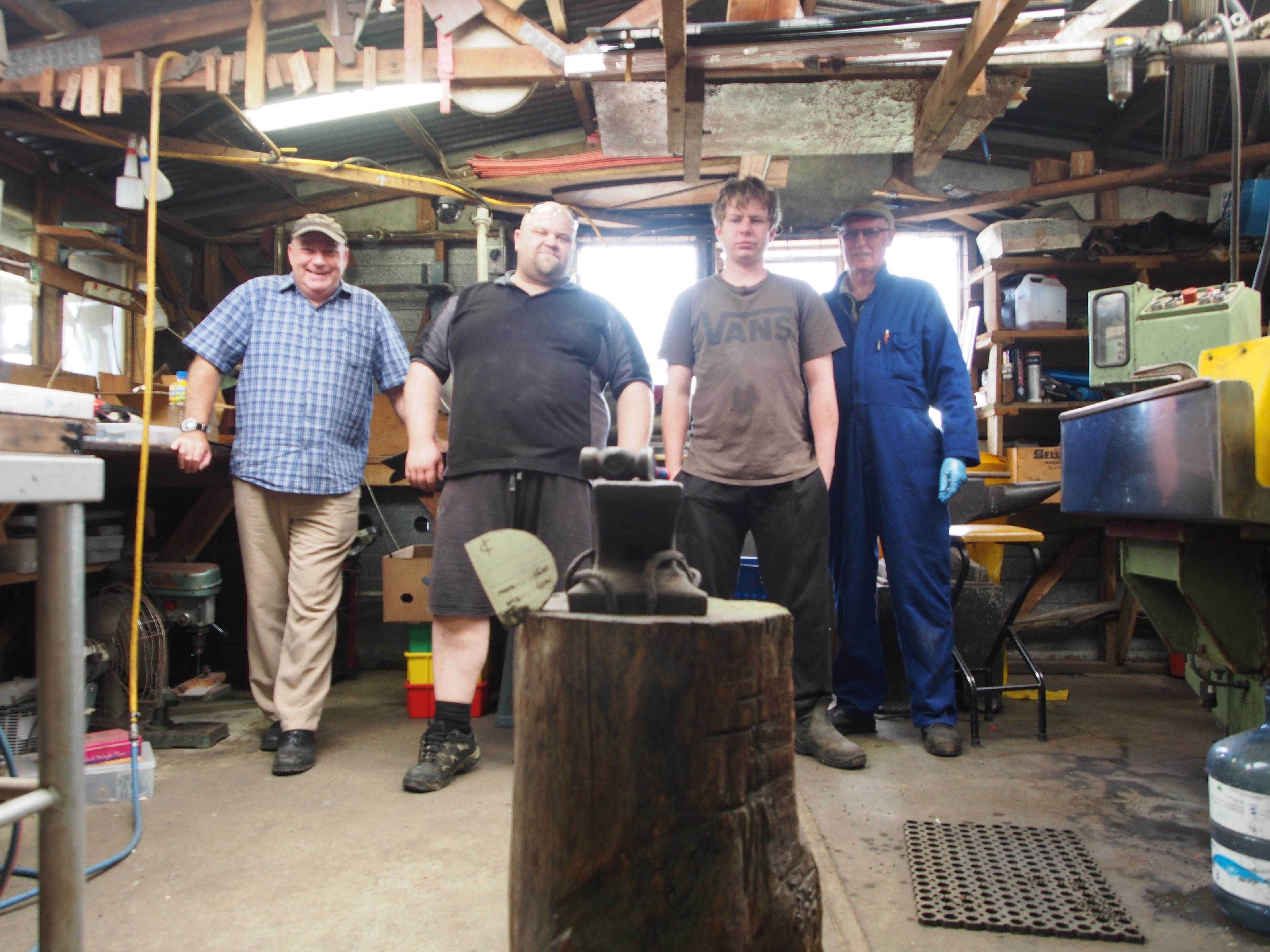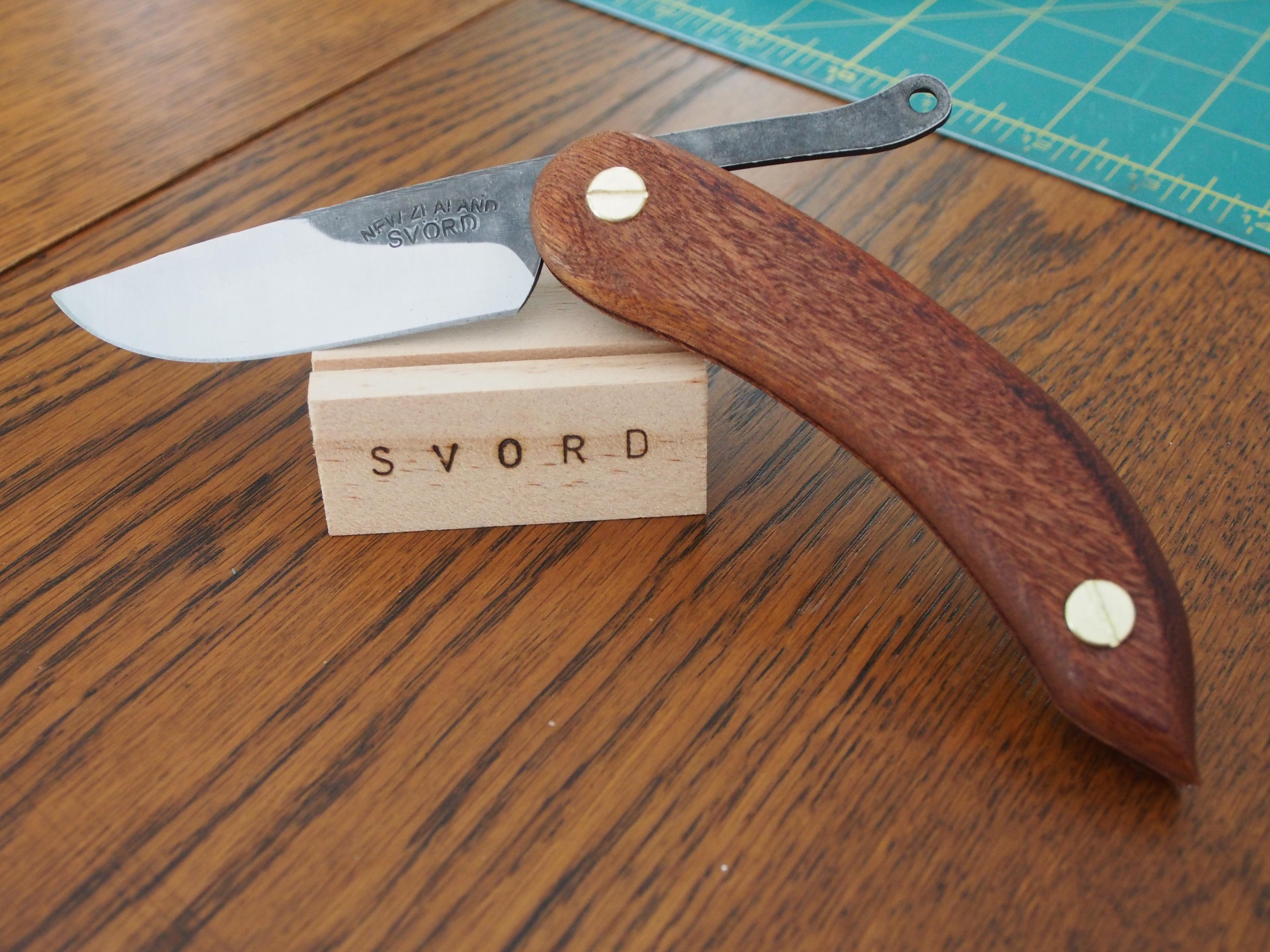So the other day I had some time on my hands and decided to pop down to Waiuku and pick up a new knife - Waiuku of course is where the Svord Forge is located and about 70 km south of Auckland.
Svord is created, owned and operated by Bryan Baker, who personally tempers each and every knife that is produced, about 150,000 now according to Bryan, in fact while he employees several engineers, for want of a better term, he is the only one who knows the secret of tempering the blades, the actual furnace is hidden behind heat proof curtains and while I was allowed a glance in the actual mechanics of what goes on in there is known only to Baker, and it is a closely guarded secret.
Bryan does two things very well, he puts a convex grind on most of his knives and he knows and tempers the three steels that he works with amazingly well.
The three steels are a stainless steel (420) that is fairly recently been added and two high carbon steels, 15N20, a Swedish steel used in making band saw blades but can also be turned into good knife blades if tempered properly and L6, which is also a tool steel but is an incredibly tough one, he reserves this for his high end or heavy use blades.
Baker says though that all the talk about which steel is the best for knives is just so much rubbish, and the real secret is in the tempering, something which he learnt from a Czechoslovakian blade master who spent ten years learning how to make knives before coming to New Zealand.
While I was there I had the opportunity to see various blades going through various stages of production from the Sword employees and the very nice old german equipment that Baker has accumulated over the years, in fact the Forge is more of a factory now, with almost all of the components being made in house, from sheaths, to making the polypropylene into handles, to making the brass fasteners for attaching the handles to the full tang blades of some of his knives to cutting out the shape, putting on the grind, in fact the only truly hand made but is what Baker does, place the blades into the furnace to be tempered and then taking them out when the alarm on his iPhone tells him its time to do so.
Svord produces a wide range of knives from one off bespoke custom pieces, to machetes, hunting knives, skinners, pocket knives, kitchen knives and several different period pieces, most famously perhaps the von Tempskey bowies which is a faithful reproduction on one of those blades that a historian had brought into the forge and Bryan copied, albeit now made with modern steel. And its one heck of a knife with a blade thats eleven inches long, in the bowie shape, made from thick tempered L6 with a convex edge, its made to be able to do everything the original blades were asked to do but made stronger and better.
Baker tries to keep the cost of his knives down to the point where ordinary people, hunters and fishermen like you and I can afford them whilst still making enough money to employee several staff and maintain his equipment and forge, and as such there is one aspect that tends to suffer slightly and thats the attention to detail of the more common knives, I have four Swords know and all of them needed a slight touch up to be made into users for me, usually a little sanding of the handle or cleaning of the thong holes, not biggie things but noticeable, but then I have bought users and so lets get on to discussing those.
The peasant knife is what may have put Baker onto the map for a lot of people, is a very simple one bladed pocket knife with an excellent 15N20 steel blade that has been tempered by Baker but unfortunately does not have a convex edge, but then it comes in at about $40 dollars and can be had with either a 3 inch or 2.5 inch blade, wooden handles or plastic or aluminium and there is one special model with a blade almost two foot long...but is mainly a display model, although it does come sharp and ready for action.
I opted for the 3 inch wooden handles one, which is the original one Baker started making, whats unique about these knives is the opening method, the blade, unlike most pocket knives has a tang that, when closed extends out the front of the blade and is opened by swing the tang in which allows the blade to swing out, then the and is secured by a pin to stop it over extending and your hand to stop in closing, its slightly uncomfortable at first, but you quickly get used to it and its a very simple and stone design, and one thats thousands of years old.
The knife is made from a few simple components, the blade, two handle slabs, a washer, a pin and two chicago screws. The blade is a simple drop point design, and is nice and sharp.
I opted for the wooden handle in part because I wanted to modify it, I have sanded off the finish, a simple stain, and have chopped off the end which was pointed and have taken a dremel to the end to smooth it out - I will stress that it needed none of this, I just wanted to do it, its my knife and I can modify it if I want to, I expect I will do a few other but and pieces to it before I am fully satisfied, but then for a knifes that costs a mere $45 its no biggies if I screw it up.
Out of the box though it came sharp enough to slice hanging paper, made short work of onions and potatoes and is light in the hand and pocket (and wallet), and is made here in New Zealand by a great bunch of kiwis, at the price you could easily afford to stick one in the tackle box (oiled because the high carbon blade will rust), back pack, glove box and anywhere else one might need a small handy sharp and strong pocket knife, perhaps best of all it certainly does not look tactical so will not offend the sheeple if used to peel an orange.
All in all its great little knife.
(my computer is playing up at the moment and won't let me load any pictures so I will post this then try and edit it to insert the pictures)
Welcome guest, is this your first visit? Create Account now to join.
Welcome to the NZ Hunting and Shooting Forums.
Search Forums
User Tag List
+ Reply to Thread
Results 1 to 15 of 15
 8Likes
8Likes
Thread: Svord forge visit and Peasant Knife review
-
21-11-2014, 04:37 PM #1Member

- Join Date
- Aug 2014
- Location
- Auckland
- Posts
- 719
Svord forge visit and Peasant Knife review
Last edited by Shelley; 21-11-2014 at 04:43 PM. Reason: photos
-
-
21-11-2014, 06:31 PM #2
Ive got a peasant knife, great blade that can get freaky sharp, nice design to, I probably prefer it over my Mercator knife.
Never argue with stupid people, they will drag you down to their level and then beat you with experience.
-
21-11-2014, 08:48 PM #3Bah, humbug !


- Join Date
- Nov 2013
- Location
- Auckland, until I can escape south....to Southland.
- Posts
- 1,699
I've 3 of Brian's knives, brilliant pieces of equipment.
Hate to think how long ago I bought the first one.
-
21-11-2014, 08:59 PM #4Member

- Join Date
- Dec 2011
- Location
- NI
- Posts
- 13,523
I don’t know what the big secret is about the heat treatment and tempering. You can only do so much with the 2 carbon steels they are using, and there is no evidence that Svord hold an edge longer than other makers using the same steel. Sounds like marketing to me.
-
21-11-2014, 09:02 PM #5
Cant beat a good Bark River knife a Tahr.
Never argue with stupid people, they will drag you down to their level and then beat you with experience.
-
21-11-2014, 09:15 PM #6Member

- Join Date
- Jun 2013
- Location
- Middle Earth
- Posts
- 4,554
I own a peasant knife. And I honestly think that the edge does not hold well. Yes you can make it sharp but it just does not last .
My opinel holds its edge better .
I can not talk for the rest of the production as I have not tried any other. But it is true that the heat treatment is one of the most important part of the process.
-
21-11-2014, 10:28 PM #7Member

- Join Date
- Dec 2011
- Location
- NI
- Posts
- 13,523
I dunno about that, but I have always thought Svord are expensive for the materials they use, and their fit and finish.
For $200 NZD landed I could get a 4” A2 steel Bark River that would in my view be a lot superior to an equivalent Svord.
I do though think that the Svord knives with a sharpening steel attached probably better suits our general approach to knives, and they are certainly good enough.
But I do think that those peasant knives are dangerous pieces of rubbish.
Another thing. I’ve seen Svords cheaper on US sites than you can get them here. You could by one from the states, add the exchange rate and postage and still be cheaper. Not sure what thats about.
Look here: http://www.knifeworks.com/fixedblades-8.aspxLast edited by Tahr; 21-11-2014 at 10:47 PM.
-
21-11-2014, 11:49 PM #8
Even though I'm a kind of fan of Svord and have owned one from nearly the start of their business model.
I agree with Tahr , " They are taking a lend of us " .
The finished quality of their current product is extrodinarily poor for the price demanded .
Its a shame really .
I've never owned a Bark River knife , but some very knowledgable people I know in the knife world rate them for value for money ,sadly Svord doesn't rate a mention apart from their unique Peasant knife , which is more nostalgia than practicality .
KenFALL IN LOVE WITH THE NUMBERS , NOT THE IDEA
-
22-11-2014, 07:06 AM #9Member

- Join Date
- Dec 2011
- Location
- Quakechurch
- Posts
- 1,756
I agree that how steel is heat treated and tempered can produce a better or worse result, depending on the expertise and experience of those doing so. But to suggest that the materials used are immaterial is laughable.. clearly Mr Baker already makes his own choices of some over another - so that kinda already makes the argument ridiculous..
Sword make good knives (if agricultural and unfinished) are considered good, and Mr Baker may be brilliant at producing good knives from whatever ingredients - but that don't mean that others aren't producing better knives with better steels... I would also argue that his tempering expertise is unlikely to be unique... mankind has been doing this for centuries and the science and methodology is well understand.
If his argument is that his product is good enough or close enough or better than without the cost of fancy steels and R&D, then best of luck to him... I personally don't agree and many others wouldn't either... but if we swallowed the argument, his business would be booming....
-
22-11-2014, 07:52 AM #10
I'm sure Mr Baker knows what he is doing and does a good job, call me a fussy bastard but if I'm paying up around $200 for a quality knife I prefer it looks a bit prettier and better made, Bark River, Doug Ritter/Benchmade is my choice of knife.
Never argue with stupid people, they will drag you down to their level and then beat you with experience.
-
22-11-2014, 10:02 AM #11Member

- Join Date
- Jun 2014
- Location
- CNI
- Posts
- 5,991
I bought a conventional svord knife a couple of years ago from H&F Taupo. it is not a flash finish but I chose it based on it's blade shape and size as a general purpose hunting knife to wear in a sheath. I have had many types of knives over the years and gutted a lot of deer. The svord is one of very few which will last gutting and cutting up a whole red deer without having to be repeatedly resharpened. I am very happy with mine.
-
22-11-2014, 02:19 PM #12
I'm toying with the idea of getting a larger svord but remain undecided. I have the mini peasant and peasant which I bought to trial the steel and the edge. Both are razors after putting them on the stone. I intend to carry the peasant as a backup knife as I have no doubt it is capable of dressing a deer should I lose or somehow break the Buck I use at the moment. I have a fallkniven F1 as well but have not had any luck butchering with the thing. Very thick, convex grind which while it feel razor sharp struggles to cut meat well. If it wasn't a gift from my dad I would likely have sold it by now. Shame, cos it held so much promise.
There are two Svords that have appeal with their black-smithed look and that's the two Von Tempsky knives - the large 11" asskicker camp knife and the smaller 6.5" bowie-styled Ranger knife. I think the look of these knives is entirely appropriate for their character and purpose, but must admit I'm hesitant to invest in the other styles yet (to be fair, the poly handled ones are pretty economical).
Certainly far from the perfect butchering knife, but has a character all of its own:

-
22-11-2014, 03:16 PM #13
-
22-11-2014, 05:39 PM #14Member

- Join Date
- Aug 2014
- Location
- Auckland
- Posts
- 719
Hey feral, it's called parallel importing, if you are big enough and ugly enough you can buy en mass and demand a discount, you may even sell at a loss on some items to put others out of business, of course if something goes wrong with your parallel imported product you need to try and send it back to the seller, then wait for them to do something about it...just saying.
-
22-11-2014, 05:43 PM #15Member

- Join Date
- Aug 2014
- Location
- Auckland
- Posts
- 719
And I totaally agree about the Svord finish, it's not the best, he seems to concentrate on the business end of the product and not the handle, but for us who use them it's the handle that will determine whether we reach for a Svord or something else more comfortable, that and whether it will do the job, mine seem to.
Similar Threads
-
Svord Golok British Army Pattern 11 inch
By Shelley in forum Gear and EquipmentReplies: 7Last Post: 13-08-2014, 09:15 PM -
Svord EDC Hiker
By Shelley in forum Gear and EquipmentReplies: 0Last Post: 06-08-2014, 03:47 PM -
this young fella came to visit
By madjon_ in forum Photography and VideoReplies: 15Last Post: 03-01-2013, 01:34 PM
Tags for this Thread
Welcome to NZ Hunting and Shooting Forums! We see you're new here, or arn't logged in. Create an account, and Login for full access including our FREE BUY and SELL section Register NOW!!






 LinkBack URL
LinkBack URL About LinkBacks
About LinkBacks





 Reply With Quote
Reply With Quote



Bookmarks